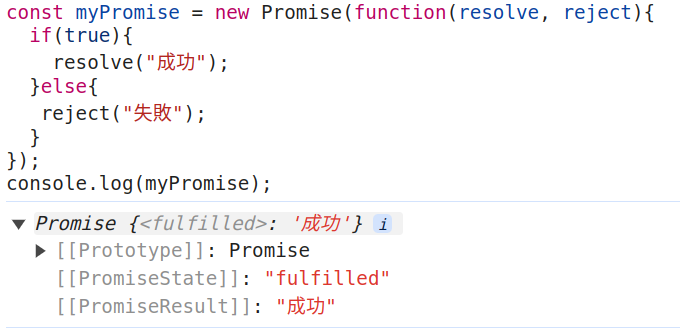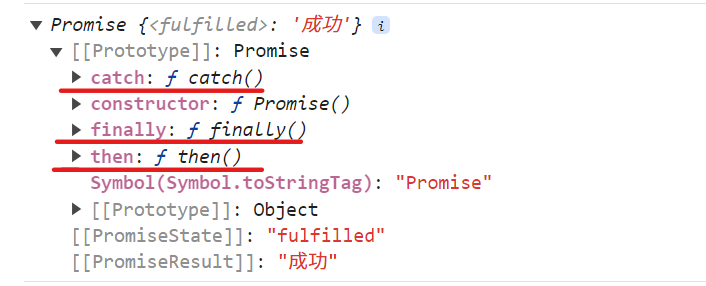const myPromise = new Promise(function (resolve, reject) {
//resolve執行成功結果
//reject執行失敗結果
});
function myPromise() {
return new Promise(function (resolve, reject) {
//resolve執行成功結果
//reject執行失敗結果
});
}
Promise基本宣告,也有看到放在funciton裡面return出來的方式。
MDN:
The eventual state of a pending promise can either be fulfilled with a value or rejected with a reason (error).
如果promise從pending變成setteld(已解決),代表有結果(fulfilled 或 rejected)。
這些狀態都會被記錄在Promise物件裡面,用開發者工具(DevTools)可以查看。
範例:
const myPromise = new Promise(function (resolve, reject) {
if (true) {
resolve("成功");
} else {
reject("失敗");
}
});
console.log(myPromise);
可以看到new Promise後產生的會是一個Promise物件。
在裡面設if...else,如果成立則執行resolve(),反之執行reject(),
我先設定if的小括號為true,讓他執行resolve()並印出。
執行結果:
展開myPromise這個物件查看內容,[[PromiseState]]顯示為fulfilled,[[PromiseResult]]為我們帶入resolve的參數值。
但是[[PromiseState]]和[[PromiseResult]]無法取得,所以要透過then()函式取得結果,then()函式參數帶入的是callback function,而這個callback function的參數帶入的就是剛剛Promise的結果,這樣就可以做到等Promise執行完有結果了,之後再執行callback的順序。
在看MDN發現的東東,之前只知道then()和catch()卻不知道有finally(),而這樣的組合讓我想到try...catch...finally這位朋友XD
先說說這三者的介紹:
是 JavaScript 中處理 Promise 結果的主要方法,用來處理 Promise 的成功或失敗結果。它接受兩個callback function作為參數,分別對應 Promise完成(fulfilled)和失敗(rejected)。
promise.then(fulfilled時執行的callback, rejected時執行的callback);
如果只要Promise的成功結果,可以只傳入第一個參數,第二個參數省略。一般錯誤處理(rejected)可透過 .catch()。
const myPromise = new Promise(function (resolve, reject) {
setTimeout(function () {
resolve("成功結果");
}, 1000);
});
myPromise.then(
//第一個callback為fulfilled
function (result) {
console.log("成功:", result);
},
//第二個callback為rejected
function (error) {
console.log("失敗:", error);
}
);
如果需要依序執行多個 promise的話,可以then()後面繼續串接then()。
補充:MDN說到
then()、catch()和finally()函式都會return a new Promise(回傳一個新Promise),因為then()會回傳一個新的Promise,所以就可以繼續使用then()方法。
const myPromise = new Promise(function (resolve, reject) {
resolve(2);
});
myPromise
.then(function (result) {
console.log("第一步結果:", result); //印出2
return result * 2; // 回傳新結果給下一個 then
})
.then(function (result) {
console.log("第二步結果:", result); //印出4
return result * 2; // 回傳新結果給下一個 then
})
.then(function (result) {
console.log("第三步結果:", result); //印出8
});
專門用來捕捉錯誤。它會忽略成功的callback,只處理失敗(rejection)的情況。
因為用then()的callback要處理成功,又要捕捉錯誤,程式碼會很長,所以透過catch()可以讓程式碼更簡潔。
範例:
const myPromise = new Promise(function (resolve, reject) {
reject("發生錯誤");
});
myPromise
.then(function (result) {
console.log("成功:", result);
})
.catch(function (error) {
console.log(error); // 印出 "發生錯誤"
});
Promise不論結果如何都會執行裡面的程式碼。它不會接收任何結果,只是單純執行callback,finally()的回傳值不會傳遞給後面的then(),因為 finally() 不會更改Promise的結果。
範例:
const myPromise = new Promise(function (resolve, reject) {
let success = false;
setTimeout(() => {
if (success) {
resolve("成功!");
} else {
reject("失敗!");
}
}, 1000);
});
myPromise
.then(function (result) {
console.log(result); // 成功的話會印出結果
})
.catch(function (error) {
console.log("錯誤:", error); // 失敗的話會捕捉到錯誤並印出
})
.finally(function () {
console.log("執行結束,無論成功與失敗都會執行"); // 無論結果如何,都會執行這一段
});
小補充:因為Promise是一個物件,then()和catch()和finally()這些其實都是Promise的方法,用開發者工具就可以查看到,也就是為什麼Promise.then()或Promise.catch()是用「點」來接,因為使用了物件的「點記法」。之前都沒意識到,都死背XD

一開始看Promise,我覺得then和catch因為裡面還有callback function,程式碼很長讓我常常看的頭腦當機...沒辦法快速解析![]()
以下可以幫助閱讀更快速,謝謝Mentor教導,在此分享給大家:
const myPromise = new Promise(function (resolve, reject) {
setTimeout(function () {
if (true) {
resolve(100);
} else {
reject(0);
}
}, 1000);
});
//原先寫法
myPromise
.then(function (result) {
return result * 2; //新結果傳遞給下一個then
})
.catch(function (error) {
return result * 3;
})
.finally(function () {
console.log("不論如何都會執行finally");
return `我是finally的return`;
})
.then(function (result) {
return result * 4;
});
頭腦先轉換成這樣理解:
//先轉換幫助理解
myPromise.then(funcA).catch(funcB).finally(funcC).then(funcD);
function funcA(result) {
return result * 2;
}
function funcB(result) {
return result * 3;
}
function funcC(result) {
console.log("不論如何都會執行finally");
return `我是finally的return`;
}
function funcD(result) {
return result * 4;
}
把then()裡面的函式都先拿出來,並修改成具名函式funcA、funcB、funcC、funcD後再放入。
.then(funcA)
這樣的意思是funcA代表註冊而已,尚未執行,等到條件成立(Promise有fulfilled)就會呼叫它。
.then或是.catch裡面的程式碼就會簡潔許多~也比較好閱讀了
Promise的結束有兩種,一種最後return,一種最後throw。
測試結果return會跑then(),throw會跑catch()
範例:
const myPromise = new Promise(function (resolve, reject) {
if (false) {
resolve("成功");
} else {
throw "失敗";
}
});
myPromise
.then(function (result) {
return result;
})
.catch(function (error) {
return error;
});
執行結果:
這次再研究Promise發現了一些之前沒注意到的事情,覺得有收穫~越來越了解它的運作,希望有幫助到大家。
以上分享~謝謝
MDN - Promise
JS 原力覺醒 Day14 - 一生懸命的約定:Promise
